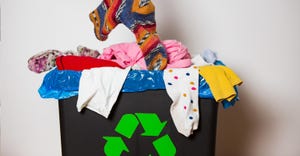Diamonds in the Rough
July 1, 2004
Michael Fickes Business Editor Cockeysville, Md.
BETWEEN NOW AND 2010, about one billion units of computer equipment will hit the scrap heap, along with 200 million television sets. The electronics recycling industry returns more than 750,000 tons of material to useful life every year, including 40 million units of computer equipment, which are recycled into 450,000 tons of various materials.
Yet, plastic poses a massive problem for electronic recyclers. Unlike standardized high-density polyethylene (HDPE) milk jugs and polyethylene terephthalate (PET) soda bottles, electronic equipment contains a legion of different plastic resins.
“There is no standardization of what plastics go into electronics equipment,” says Patricia Dillon, a principal with Dillon Environmental Associates of Merrimac, Mass. Dillon also is project director of the Stakeholder Dialogue for Recycling Engineering Thermoplastics, a study group operated through The Gordon Institute at Tufts University, Medford, Mass. “Manufacturers select whatever plastics and resins suit their particular requirements — from aesthetics to price. There are five major resins and up to 17 in all. To recover valuable materials, you have to separate the resins.”
To keep up with the rising tide of obsolete electronic equipment, and to help recyclers separate reusable plastic resins from the e-waste, the Institute of Scrap Recycling Industries Inc. (ISRI), Washington, D.C., recently published a set of recycling guidelines. Developed by the Stakeholder Dialogue, the guidelines aim to organize a more comprehensive electronic recycling effort.
Last year, the Stakeholder Dialogue conducted discussions with companies from across the electronics and plastics supply chain with the goal of sorting out the various plastics used in electronic products. More than 80 organizations participated in the discussions. In 2003, the group issued “Guidelines for Electronics Scrap: ES-2003.”
Adopted by ISRI and published in the association's “Scrap Specifications Circular 2003,” the guidelines can be found at www.isri.org/specs. They identify 34 different categories of post-industrial acrylonitrile-butadiene-styrene (ABS); polycarbonate (PC); polycarbonate acrylonitrile-butadiene-styrene (PC/ABS); high impact polystyrene (HIPS); polyphenylene ether (PPE); and polyvinyl chloride (PVC) resins, as well as inseparable multi-resin blends (classified as “all”). The comprehensive sorting scheme details the listing material, source, material origin, plastic resin type, bulk density, size, shipping, color, haz mat, moisture, flame retardant, contamination and total nonplastics characteristics of each type of electronics scrap plastics (ESP).
The guidelines earned the top environmental award for 2003 from the Society of Plastics Engineers' Global Plastics Environmental Conference. When applied, the guidelines advise de-manufacturers on how to identify and separate different plastic resin categories so that the resins are not contaminated and can be shipped to appropriate manufacturers for reuse.
As an example, when a de-manufacturer receives a load of television sets, he will consult the guidelines to identify the categories of plastic in the sets and the appropriate way to code those plastics. Then, when the manufacturers receive the plastics, the codes should remove confusion about what types of plastics they're handling or whether they should be concerned about cross-contamination.
“The goal of all these recommendations is to help make materials more valuable to recyclers,” Dillon says. “By sorting resins into various categories, recovered volumes of different kinds of plastics will increase. Recyclers with larger volumes will find it easier to create markets. Our recommendations are baby steps, but if we take enough baby steps, maybe we can change the system.”
SUPPORTING THE PROCESS
“Recommended Criteria for Plastics in New Products and End-of-Life Management,” a set of guidelines developed by the Stakeholder Dialogue, suggests several ways to improve the plastics recycling process:
Use recycled resins;
Eliminate flame-retardants containing bromide that create additional classes of plastic for recyclers;
Reduce heavy metals in components;
Minimize paints and coatings; and
Code plastic components for easier sorting during de-manufacturing.
A hierarchical method for evaluating how recycling contractors deal with electronics products also is included in the guidelines.
You May Also Like


